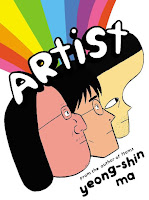“All phenomena orginate in the mind.”
You often find this in Buddhist
teachings. For the longest time, I wasn't sure how to approach it.
Like that tree in my yard. I'm pretty sure I'm not projecting it
with my mind. Other people see it, and can touch it. So how does it
originate in my mind?
Sometimes it's easy to get bogged down
in syntax where the teachings are concerned. We can tend to apply
very literal interpretations, which is what I believe I'm doing here.
I had a moment of insight as I ran at North Ponds yesterday, with an
icy wind blowing off the lake to spur me on. I noticed a fallen leaf
on the asphalt path as I came up to the front of the park. It was
multi-colored, with brown and orange and some green mixed in. The
edges of the leaf were curled over, so that it appeared to be a pile
of something, rather than a dead leaf. From the odd assortment of
colors, I assumed it was a pile of dog shit. At first glance, my
brain registered this, and I almost immediately felt a slight wave of
nausea. A few seconds later though, I realized it was a leaf, and
the nausea instantly disappeared.
This proves that our senses aren't very
reliable, or “deceivers”, as the Buddha called them. But it also
effectively demonstrates the point above. Other matter does exist
around us, and we're not beaming it into existence with mind rays.
What originates in the mind is our tendency to label, to ascribe
characteristics, to jump to conclusions and place objects and
experiences into categories. All of this conceptual thinking leads
us very far away from an open and natural way of living. We use our
brains to build boxes...and endlessly compartmentalize. As the sages
teach, it's not long before we're stuck in attachment and aversion
(for example, “what a beautiful leaf!” and “ugh, dog crap”).
My example is rather trivial. We engage in this type of behavior
every day on much weightier issues.
It isn't a great leap to apply this to
trees or other simple physical objects. We see a tree, but the
building blocks of this tree and everything else are atoms. If we
could see at that level, we'd notice that atoms are mostly space.
Mostly...emptiness. What we call a “tree” is really our
conception of a huge number of atoms arranged in a specific fashion.
We sense only through a thin slice of the possible spectrum.
Off to get groceries, where I'll once
again try to convince myself that those cookies are mostly made of
space.



